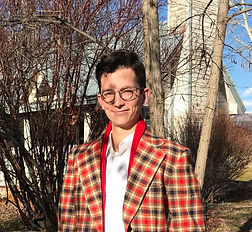



CRP 165
Albuquerque, NM
Patrick Baca-Chandler
10/8/2019

Patrick Baca-Chandler is currently a third-year fine arts major at the University of New Mexico, focusing on design concentrations using digital and physical formats. Patrick is a 14th generation inhabitant of New Mexico and growing up around an extremely diverse ecosystem, that he has seen degrade, has affected his practice substantially. One of my many goals when it comes to artistic expression is to relay what my true feelings about an issue are. Alternatively, another major influence is the influence my work has on those that then feel inspired to do something or act on these things that we say but never quite get to the point of action.
In my planning course here at UNM, the topic that impacted me the most was the idea of our nation being shaped by the outcome of the second world war. More specifically, the trend of cities promoting movement into the suburbs by using the V.A loans initiative. As well, the fact of producing 10 million more kids upon returning from the war is an insane figure and frankly, one I did not know.
The reason this topic impacted me personally was that I am two generations separated from one of those soldiers coming back from WWII and one generation from a product of the proverbial “baby boom” of the fifties. This fact, being what it is, makes me feel more than ever connected to the decision made to promote homeownership and independent family life in the middle of the twentieth century. I say this because my Dad was extremely affected by this life, so much so that at 18, he ran away from home. This is understandable because at the time it was more of a political battlefield than anything, Mississippi that is. This was in order to make a life for himself that was different from the mundaneness of that of his fathers. But that is when he was young and didn’t know anything but this life. Now in his mid-sixties, my father is living much the same life that my grandfather did, work in the city and live in a suburb, but he just had a different path there.
This opens up the question, how did this idea that the ideal of life is owning your own land, living and working in two different areas, and raising a family, still affect the person that grew up that way and swore that he would not follow in those footsteps. It is because it promotes the idea of success and essentially manliness in the most base sense possible. The fact that you worked, or served, for your time and now you are being rewarded for “sticking with it” all those years. Frankly, I think that it turns working into the necessity of people, removing all passion from the act. It is assumed that you will fall in line and take the first opportunity to make money that you can, in order to retire one day and do nothing. This is the general fault I see in the need to push for living outside the city and homeownership, but I am happy that my grandfather chose to do just that.
All of this aside, there is another outcome of this trend of urban planning and the circles that it creates throughout history. That being what to do once the section of the planned environment is no longer being used at the same capacity as it was built for. What happens to the suburbs when the majority of people are moving to the inner city and vice versa. Over time, what are the ways in which our planning has had to adapt and what ways can be implemented for the future in order to anticipate movement too and from these zones of preference? Concerning this issue is auxiliary reasons to plan for the future of life in urban and rural cities across the world.
One is the effect that traveling large distances has on the planet, more specifically in automobiles. This is the biggest issue of our current generation and all possible future generations. The idea that we need to live far away from where we work in order to create two separate worlds of living, is inherently extremely detrimental to our air and consequentially our ecosystems that depend on the clarity of such. The trend that we see now with people moving more to the inner cities, I believe, is a hint as to where the focus needs to be placed within the city planning division of all cities and central governments. In this way, we can see a clear way forward on a road that is slowly filling with fog.
When asked to expand upon a topic for this blog, I could only think of one way forward. The only thing that matters in a world of distractions is the answer to the biggest question we have ever had to face, how are we going to save this planet. Now there is no short term solution to this, but that does not mean there is nothing to be done. Action is the clearest form of communication in a situation such as this and talking about it is the first step towards this.